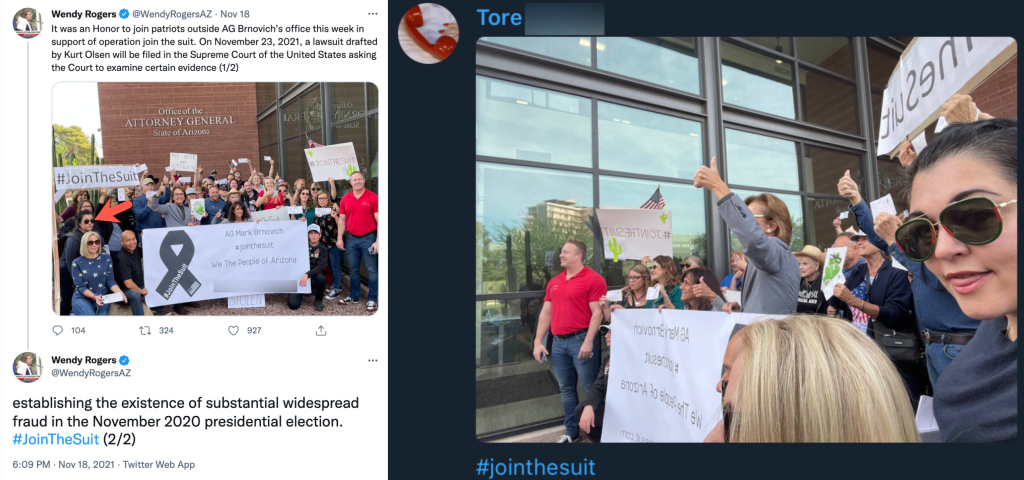The QAnon Cult Isn’t Flaming Out, But Morphing Into A Dangerous Political Movement

Reprinted with permission from Media Matters
In early 2021, there was speculation that the movement built around the QAnon conspiracy theory had finally reached an end, with “Q” -- the central figure of QAnon -- having gone silent in December 2020. But the year started with dozens of QAnon supporters participating in an assault on the United States Capitol, fueled by a belief in false claims of large-scale voter fraud the QAnon community helped spread. And the events of January 6 were the harbinger of what was to come: a year in which QAnon influencers and adherents promoted conspiracy theories and falsehoods about the 2020 presidential election, helped organize efforts to challenge or “audit” the election results, and aided in an alleged plot that, if successful, may help sway the outcome of future elections at the state and national level.
An alleged plot announced by Jim Marchant, a former member of the Nevada state Assembly and now a Nevada secretary of state candidate, is a primary example of how dangerous QAnon became in 2021. On October 25, Marchant took the stage at the QAnon-supporting “Patriot Double Down” conference, claiming that he lost his congressional campaign due to voter fraud. Marchant then said he was asked to “put together a coalition” in swing states “of other like-minded secretary of state candidates” -- referring to the officials that help run elections -- and that he had successes with the involvement and recruitment of QAnon-connected figures thus far.
Although there had been discussion about QAnon dying out in 2021, efforts like Marchant’s show that QAnon has continued to erode our democratic system and may even pose threaten a constitutional crisis -- even without “Q.” Though several social media platforms had finally announced crackdowns on QAnon by early 2021, these efforts were too little too late. By not dealing with QAnon earlier on (Facebook even spent years algorithmically promoting it), these platforms enabled the community to grow, becoming so big and organized that adherents no longer need their titular leader. Meanwhile, it’s become an easy vehicle for political figures to advance anti-democratic agendas.
Some Thought 2021 Was The Year QAnon Would Flame Out -- And They Were Wrong
After Q fell silent in December 2020, some speculated that 2021 would be the end of QAnon. The conspiracy theory had been around for more than three years at that point, starting in October 2017, when an anonymous figure known as Q posted on message board site 4chan (and later on 8chan/8kun), claiming to have “Q” government clearance and promising to have an inside scoop showing then-President Donald Trump had a secret plot that would take down his perceived enemies, the “deep state,” and a cabal of pedophiles.
Over the following years, the conspiracy theory grew on mainstream social media platforms, slowly but steadily building a network of Twitter hashtags, Facebook pages and groups, and YouTube channels, and it was boosted by other conspiracy theory figures like Infowars founder Alex Jones. During that time, some of its followers engaged in violent or threatening acts, including murders and kidnappings, and multiple government agencies issued internal warnings about it. (The FBI issued a warning as recently as June of this year).
The conspiracy theory had a breakthrough year in 2020, when consumption of QAnon-related content boomed on social media due to the coronavirus pandemic. Meanwhile, two people who had expressed some level of support for QAnon were elected to Congress, and Trump praised the conspiracy theory’s followers.
But starting in summer 2020 and through January 2021, Facebook, YouTube, Twitter, and TikTok finally announced crackdowns on QAnon ( resulting in a decrease in QAnon-connected phrases on those platforms). Q went dark after December, and despite the January 6 insurrection and the QAnon community’s predictions that Trump would somehow stay in office, Joe Biden was inaugurated as president. Although this did confuse and disappoint some followers, the result was not the end of QAnon, but a shift in the community.
Rather than give up, QAnon supporters said that “the task of Q was completed” because “the Q team [had] put out enough info” and had “created an army of digital soldiers” that would not “exist if there was no Q.” Supporters also claimed that Q was “a way to teach people how to research and how to look into things themselves” and that thanks to Q’s “guidance,” it was now time for individuals to “fight for our country.” One QAnon show host (who participated in part of the insurrection) even said that additional Q posts were not needed as “the point had been made. They were meant to wake people up, to push us to stop looking outside ourselves.” In fact, throughout the year, the community -- including political figures like Marchant -- actively tried to escape the “QAnon” tag, echoing Q’s “camouflage” command in 2020, which asked followers to deny that QAnon existed.
QAnon also continued to gather significant support among Republicans. The Daily Beast’s Will Sommer said in November that a pollster told him that “QAnon’s never been more popular in her polls of fellow Republicans.”
A main reason for the QAnon community’s resilience is the motivating power of false claims that “we've got fraudulent elections … to deal with” and that Biden was not the rightful president, which meant the election -- and the presidency -- could be “restor[ed] … back to Trump.”
QAnon, Trump-connected Figures, And The Idea Of Trump’s 'Reinstatement'
After Biden took office, the QAnon community used false voter fraud claims to rationalize that somehow Biden was a “fake president” and would be removed from office, or that Trump and/or other forces were still in control.
Some even called for a military coup against Biden, with one QAnon influencer, David Hayes (known online as “Praying Medic”), saying the military was “the last line of defense against tyranny, and I think they're going to be forced to step in.” This narrative played out most starkly when the QAnon community applauded Myanmar’s military in February for overthrowing the civilian government and imprisoning its leaders over claims of voter fraud, calling it a model for what should happen in the United States.
QAnon supporters also claimed Trump would somehow be reinstated as president -- even initially settling on a specific date of March 4. The false claim gained enough traction that it became one of the reasons almost 5,000 National Guard troops remained in Washington, D.C., after January 6. One QAnon supporter told an on-duty soldier outside the Capitol on March 3 that he was considering “test[ing] the National Guard tomorrow to see if they were loyal to the people or to the President.”
After nothing happened on March 4, some QAnon supporters continued to claim that Trump would be “reinstated.” In particular, some focused on claims from pro-Trump businessman Mike Lindell, one of four prominent QAnon-connected players -- along with Sidney Powell, Michael Flynn, and Patrick Byrne -- to push the reinstatement claim. And all four are central to QAnon’s political influence.
Mike Lindell
Lindell had met with Trump days before Biden’s inauguration to float the idea that Trump use martial law to stay in office, a call that had been pushed by QAnon supporters. Lindell also has other ties to QAnon, including helping the community financially.
Originally, Lindell claimed that based on the supposed evidence of voter fraud he had, “Trump will be back in office in August” -- a claim that Trump himself reportedly came to believe. Lindell moved the date back of this reinstatement and, in November, released a supposed complaint that he promised would get the Supreme Court to act.
In response to Lindell’s claim, one QAnon influencer named Terpsichore Maras-Lindeman, known online as “Tore,” launched a “#jointhesuit” campaign to urge her followers to get state attorneys general to sign on, with some of her followers saying they had spoken with Republican state officials in multiple states about it. Arizona state Sen. Wendy Rogers even participated in a #jointhesuit event to get the attorney general of Arizona to sign on, and Tore joined her in person.

Sidney Powell
Former Trump campaign attorney Sidney Powell is another QAnon-connected figure who promised Trump’s reinstatement. Powell helped Trump in his legal campaign to overturn the election, including by citing multiple QAnon-connected figures and claims, and Trump considered naming her a special counsel on voter fraud. At a QAnon conference in Dallas in May, Powell said that due to voter fraud, Trump “can simply be reinstated.”
Michael Flynn
Another figure with deep ties to the QAnon community is former Trump national security adviser Michael Flynn -- whom Trump considered making the FBI director and who also met with Trump post-election. At one point before Biden’s inauguration, Flynn called for martial law, and at the QAnon conference in Dallas, he echoed the community’s support for a Myanmar-style coup in the U.S. On QAnon supporter Ann Vandersteel’s show in June, Flynn said that due to voter fraud, “you reinstate the guy [Trump] and you get rid of the guy [Biden] that’s there.”
Patrick Byrne
Former Overstock CEO Patrick Byrne, who has a number of connections to QAnon shows and influencers, also met with Trump post-election. Byrne has a significant number of QAnon connections, including apparently having a QAnon influencer on his group’s leadership committee and endorsing QAnon’s “digital soldiers.” He claimed, “You’ll see Donald Trump back in [office] sometime next year.” In separate videos, Byrne promoted Lindell’s Supreme Court complaint before it was released, along with Tore’s campaign for it.
In June, the Department of Homeland Security expressed alarm about the Trump reinstatement claim, noting its spread among “Qanon conspiracy theory adherents.”
QAnon, Arizona, and the “audit” and “decertify” movement
As part of this push for reinstatement, much of the QAnon community latched onto an effort to launch “audits” in swing states Biden won -- in particular Arizona -- to prove voter fraud. QAnon supporters believed that the supposed audit, launched by the Arizona state Senate to look into ballots cast in Maricopa County, would start a domino effect of audits in other states, leading states to “decertify” their election results and causing Trump’s reinstatement.
The Arizona audit was extensively intertwined with QAnon:
- Doug Logan, the CEO of Cyber Ninjas, the company conducting the audit, was involved with efforts by Powell, Flynn, and Byrne to push voter fraud claims, along with QAnon-supporting attorney Lin Wood.
- Logan helped with a lawsuit from lawyer Matthew DePerno in Michigan, where DePerno is also running for attorney general in 2022. DePerno appeared to follow and amplified multiple QAnon influencers including former 8kun administrator Ron Watkins (known online as “CodeMonekyZ”) and Praying Medic, the QAnon influencer who called for a military coup.
- Byrne’s The America Project was the biggest funder of the audit, putting in more than half of all the funding. Other primary funders included Flynn’s group America’s Future, Powell’s group Defending the Republic, and Legal Defense Fund for the American Republic, with which DePerno is involved. Wood has also donated funds.
- Among those on Cyber Ninjas’ staff during the audit were Austin Steinbart, a QAnon influencer known online as “Baby Q,” and Shiva Ayyadurai, who has pushed QAnon and is now running for governor of Massachusetts. Ayyadurai presented part of the findings of the audit before the state Senate in September.
- Logan appeared in an election conspiracy theory film focusing on the audit called The Deep Rig, based on a book Byrne wrote, whose premiere featured QAnon figures.
- Liz Harris, a former Republican candidate for Arizona state House who has pushed QAnon, ran a “canvassing” effort (which she promoted on multiple QAnon shows) to look for supposed voter fraud in Maricopa County that Cyber Ninjas has suggested was connected to its efforts. Harris has also claimed to have met with Logan multiple times, and Logan apparently has promoted Harris’ efforts directly. She has also met with Lindell, Byrne, and Powell.
- Harris has said she worked with election conspiracy theorist Seth Keshel, who is involved with The America Project and who was part of the team with Logan aiding the Michigan lawsuit. Keshel is a supporter of the QAnon MatrixxxGrooove Show.
- Bobby Piton, a QAnon supporter who is currently a U.S. Senate candidate in Illinois, aided Logan with the audit, has worked with Harris, and apparently spoke with members of the Arizona state Senate. (Piton also appears in The Deep Rig.)
- Some of the biggest boosters of the audit in the Arizona state legislature have affiliated themselves with QAnon. Arizona state Sen. Wendy Rogers has promoted QAnon and repeatedly gone on QAnon shows to promote the audit and other “decertification” efforts. State Rep. Mark Finchem (who is running for Arizona secretary of state in 2022) has promoted QAnon narratives. And state Senate Majority Whip Sonny Borrelli has also gone on multiple QAnon shows. All three (along with another state representative) attended a QAnon conference in Las Vegas to discuss the audit.
Another connection between the audit and QAnon was a conspiracy theory, based on a Q post, that Trump watermarked ballots so that Democrats would be caught cheating by using fake ballots without watermarks. The audit workers reportedly used UV light to examine ballots to look for supposed watermarks, and some 2022 state secretary of state candidates, including Arizona’s Finchem, have now called for watermarked ballots to prevent supposed fraud.
While the audit did not find the promised fraud, the audit movement did spread elsewhere -- along with more QAnon connections.
In Wisconsin, one of the most prominent advocates for the decertification of the state’s results was Wisconsin state Rep. Timothy Ramthun. Ramthun called for Cyber Ninjas to aid with an audit in the state in a video titled “The Calm Before The Storm” -- a key phrase in QAnon lore. He also appeared on a QAnon channel to push for an audit.
And in Pennsylvania, one of the most prominent advocates for an audit was state Sen. Doug Mastriano, who also visited Arizona to observe its audit. Mastriano has previously expressed support for QAnon. The founder of Audit The Vote PA -- a group associated with Mastriano -- is also a QAnon supporter.
An alleged QAnon-connected plot that could lead to a constitutional crisis
As the audit movement spread around the country, Nevada secretary of state candidate Jim Marchant took the stage at the QAnon conference in October in Las Vegas. Marchant -- who is friendly with the conference organizer, who is also a QAnon influencer -- baselessly complained that he was “a victim of voter fraud” in his 2020 congressional bid and said that he worked with Juan O. Savin, a QAnon influencer who some QAnon supporters believe is John F. Kennedy Jr., to supposedly “expose … the fraudulent election here in Nevada.”
Video fileVideo Player
Marchant suggested election fraud had supposedly been occurring “for a long time” and involved Democrats winning secretary of state offices around the country and “in key swing states.” He said that “we need to take back” those offices in 2022 because “they are the most important election in our country in 2022” as they “control the election system.” And he claimed he was asked to run for secretary of state in Nevada and to “put together a coalition of other like minded secretary of state candidates.”
Marchant said the “coalition,” which he developed with Savin, in May had its “inaugural meeting to start strategizing,” which included Lindell, Byrne, Jim Hoft and Joe Hoft of The Gateway Pundit, and Brian Kennedy of the Claremont Institute. The Gateway Pundit is a far-right blog that has previously given credence to QAnon and has played a major role spreading voter fraud misinformation. The Claremont Institute also has far-right ties.
Marchant named some secretary of state candidates who have expressed support for QAnon as part of this recruitment effort: Arizona’s Finchem and California’s Rachel Hamm, both of whom also attended the conference. Marchant also mentioned trying to recruit Pennsylvania’s Mastriano to run for governor because in Pennsylvania, the governor appoints the secretary of state. Another secretary of state candidate who attended the conference, Michigan’s Kristina Karamo, said she had been “asked to be a part of the coalition” and that “we came here to Vegas and we sat in the room and we met and we talked, all of us on the coalition together.”
Trump has also endorsed some of the candidates connected to the effort. If elected, these figures could potentially try to use their office to cast doubt on or even reverse a future presidential election result.
Even without Q, QAnon has continued to corrode our democratic system -- and social media made that possible
Despite Q’s disappearance, the crackdowns by the platforms, and Biden’s assumption of office, QAnon did not go away. Animated by a belief that Trump was somehow still in power or would be reinstated, the community focused intensely on proving voter fraud. QAnon’s influence on the audit and the decertify movement, particularly in Arizona, is an extension of the influence QAnon had on Trump post-election, via some of the same figures.
The continued political influence of QAnon traces back to the original sin of the social media platforms. Failing to take action on QAnon sooner let it grow unchecked, becoming big and organized enough to influence politics. As Rogers herself said, the audiences of QAnon shows were, in part, helping “mov[e] the needle.”
And now this QAnon infrastructure -- in place due to the catastrophic mistake of the social media companies -- has helped cause an insurrection, struck at the integrity of our democracy, and sowed the seeds for a potential constitutional crisis.8
Reprinted with permission from Media Matters








